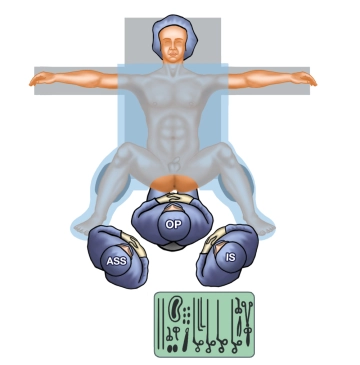- proximal, transsphincteric anal fistulas
-
Indications
-
Contraindications
- distal fistulas
- rectovaginal fistulas
-
Preoperative Diagnostics
- Proctological examination: inspection, palpation, proctoscopy, rectoscopy
- additionally: fistula probing
- in special cases: anal endosonography, MRI
-
Special Preparation
- Usually, orthograde bowel lavage is required (generally recommended, but not supported by strong evidence).
- A fistula without acute inflammatory changes must be present. This is usually achieved by inserting a thread (e.g., Vessel-Loop®) for 8-12 weeks.
-
Informed consent
General:
- Bleeding
- Thrombosis
- Embolism etc.
Specific:
- Fistula persistence
- Recurrence
- Abscess
-
Anesthesia
Depending on the general condition of the patient:
- Intubation anesthesia (Intubation anesthesia, Laryngeal mask anesthesia)
- Regional anesthesia (Spinal anesthesia, Caudal anesthesia)
-
Positioning
![Positioning]()
- Lithotomy position
-
OR Setup
![OR Setup]()
The surgeon sits in front of the patient positioned in the lithotomy position, with the first assistant on the left side. The scrub nurse stands laterally to the right behind the surgeon.
-
Special instruments and holding systems
- Standard proctology tray
- Anal Fistula Plug®
-
Postoperative treatment
postoperative analgesia: Non-steroidal anti-inflammatory drugs are generally sufficient; if necessary, an increase with opioid-containing analgesics can be made.
Follow the link here to PROSPECT (Procedures Specific Postoperative Pain Management).
Follow the link here to the current guideline Treatment of acute perioperative and post-traumatic pain.
medical aftercare: none
thrombosis prophylaxis: In the absence of contraindications, due to the moderate thromboembolic risk (surgical procedure > 30 min duration), in addition to physical measures, low molecular weight heparin should be administered in prophylactic, possibly weight- or disposition risk-adapted dosage until full mobilization is achieved.
Note: Renal function, HIT II (history, platelet control)
Follow the link here to the current guideline Prophylaxis of venous thromboembolism (VTE).
mobilization: immediately
physical therapy: none
dietary progression: Regular diet, liquid formular diet, or parenteral nutrition (decision by the surgeon, as there is no evidence)
stool regulation: none
incapacity for work: generally 4 weeks (physical rest for 4 weeks is recommended)


